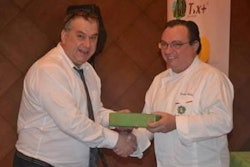In cooperation with local pig advisers, The (Danish) Pig Research Center developed a new management tool for pig producers to enable them mix their own feed on-farm with increased efficiency. The program consists of 25 fact sheets describing the most essential processes in feed production - from ingredients to the finished diet.
It also includes a range of checklists and work plans that can be tailored to each pig farm to assist in the organizing everyday routines. The center recommends using the tool together with an adviser who is also an expert in this area. In addition, mini user-guides have been developed in conjunction with major producers of on-farm mixing equipment, covering the most common feed mixing computer systems. The mini user-guides describe the most frequent functions.
Research the cost of grinding wheat, barley
In cooperation with energy suppliers in Denmark, The Pig Research Center tested six feed mills designed specifically for on-farm mixing. All mills were tested with barley (fine, medium and coarse grinding) and wheat sufficiently dry for storage (fine grinding only). The mills were equipped with 22 kW motors.
All tested machinery fulfilled the requirement for fine grinding, and only small differences in energy consumption and capacity were observed between the different brands. A disc-type mill was found to have the lowest energy consumption at fine grinding, while at medium and coarse grinding of barley, energy consumption was largely identical with that of hammer mills.
At fine grinding, hammer mills used on average 1.03 kWh per 100 kg wheat and 1.53 kWh per 100 kg barley. This demonstrates that it requires approximately 50 percent more energy to grind barley than wheat. Mill capacity at fine grinding averaged 2,600 kg/hour for wheat and 1,800 kg/hour for barley.
With these three levels of grinding of barley, 56 percent, 63 percent and 84 percent, respectively, of the ground particles had a particle size below 1 mm. Energy consumption increased by 0.24 kWh per 100 kg barley when the percentage of particles below 1 mm increased by 10 percentage units. At the same time, mill capacity dropped by 400 kg/hour, which further increased the overall energy consumption as trough augers, elevators, grain cleaning equipment and mixer had to operate for longer in the feed mill.
Based on the outcome of this study, the increased energy required for fine grinding is estimated to constitute around 10 percent of the overall savings observed from improvements in animal performance.
Nevertheless, it is still recommended that grain mixed on-farm be ground sufficiently fine to achieve a good feed conversion ratio, without being so fine that gastric ulcers reach unacceptably high levels.

















